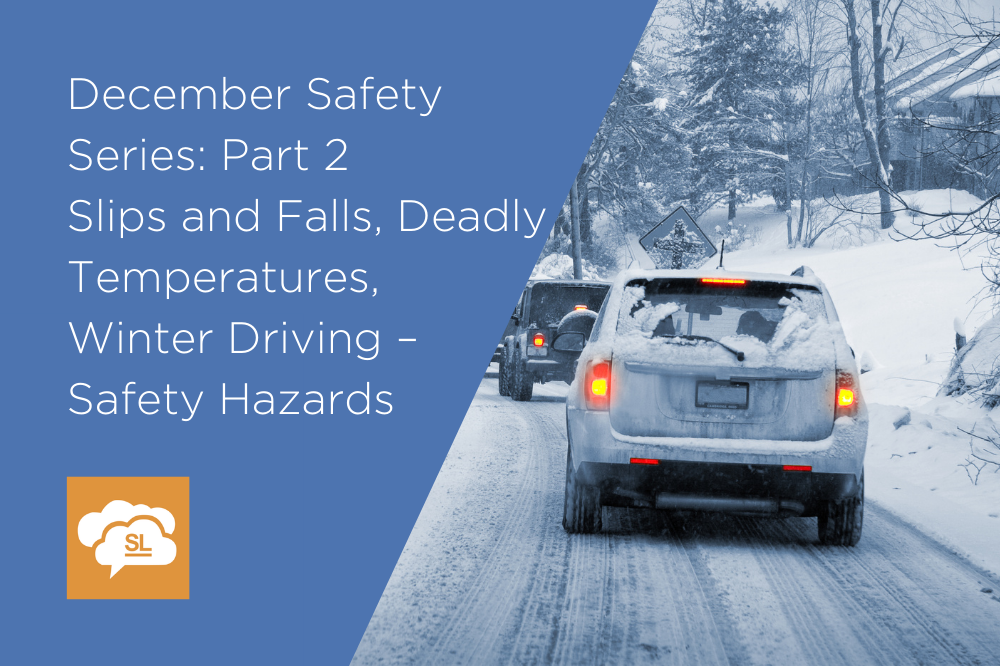Slips and Falls, Deadly Temperatures, Winter Driving – Address These Safety Hazards Now
December Safety Series: Part 2
Table of Contents
The safety hazards of slip and fall injuries
The safety hazards of cold temperatures
Hypothermia
Frostbite
The safety hazards of winter driving
The safety benefits of a strong safety culture
This blog article is a continuation from December Safety Series Part 1: Fires, Falls and Depression: The Holiday Safety Hazards of Working from Home
As the temperatures plummet and the snow, ice, and rain increase, slip-and-fall injuries see a spike, particularly for those working in these conditions. According to the US Bureau of Labor Statistics, in 2017, more than 20,000 work injuries were related to ice, sleet and snow. The workers most at risk are obviously those working outside, facing the elements, including farmers, fishermen, snow cleanup staff, first responders like paramedics, construction workers, security personnel, and community healthcare workers.
The safety hazards of slip and fall injuries
There are a number of things that employers can do to reduce these types of injuries. First, make sure that all walkways are cleared of snow and ice, and are covered with sand and salt if needed. If workers are using alternative routes like shortcuts and paths, make sure those are taken care and if possible, converted into walkways. And mark hazardous areas, using temporary signs, cones, or barricades to warn passing workers.
Additionally, it is up to the employer to encourage or even provide the proper footwear like insulated and water-resistant or water-proof boots. Workers can also use rubber over-shoes to provide grip on slippery surfaces which can easily be fit over your existing footwear.
The safety hazards of cold temperatures
But in addition to the prevalence of slips and fall injuries, the low temperatures also impact the workers’ safety which is dependent on six factors which employers must consider when protecting their team:
Air temperature
Wind chill and speed
Humidity - “Water conducts heat away from the body 25 times faster than dry air.”
Physical activity - “The production of body heat by physical activity (metabolic rate) is difficult to measure. However, tables are available in literature showing metabolic rates for a variety of activities. Metabolic heat production is measured in kilocalories (kcal) per hour. One kilocalorie is the amount of heat needed to raise the temperature of one kilogram of water by 1°C.”
Work/rest schedule - “The warm-up breaks required for working in cold conditions and the normal breaks to be provided every two hours. The schedule allows additional breaks for workers as the wind velocity at the work site increases and/or the temperature drops.”
Protective clothing – this also includes personal protective equipment.
The Centers for Disease Control (CDC) and Prevention says workers who work in cold weather are at risk to a number of safety hazards such as hypothermia, frostbite, trench foot, and chilblains, which are ulcers formed by damaged blood vessels in the skin caused by the repeated exposure to temperatures just above freezing. The CDC provides a number of recommendations to protect your outdoor workers like wearing the appropriate, warm clothing, sufficiently protecting the face, ears, and limbs, moving to warm locations on breaks, carrying extra gloves, toques, and clothing, and monitoring these employees such as an automated check-in system.
Do you know the symptoms of hypothermia and frostbite? Make sure your team does as well so they can help if you are experiencing these symptoms.
Hypothermia
Shivering or shaking
Lack of coordination
Drowsiness or confusion
Slurred speech
Frostbite
Skin that is very cold and turns numb, hard and pale
Blisters or swelling
Joint or muscle stiffness
The safety hazards of winter driving
If your workers are driving to different sites, the issue of winter driving must be addressed as well. Employers can make sure workers recognize the hazards of winter weather driving. For example, train or educate your team about driving on snow- and ice-covered roads and ensure they are licensed (as applicable) for the vehicles they operate.
The Occupational Safety and Health Administration recommends that employers provide an emergency kit for winter-driving workers with the following items:
Cellphone or two-way radio
Windshield ice scraper
Snowbrush
Flashlight with extra batteries
Shovel
Tow chain
Traction aids (bag of sand or cat litter)
Emergency flares
Jumper cables
Snacks
Water
Road maps
Blankets, change of clothes
The safety benefits of a strong safety culture
In closing, one of the most effective steps an employer can take to prevent their team during the winter months is to promote and build a strong safety culture. This type of culture is an environment where your workers feel comfortable expressing any safety concerns and providing valuable feedback and input to keep the team safer. When you listen to your team without any judgment, it builds a culture of respect and trust where safety is a priority for everyone.

